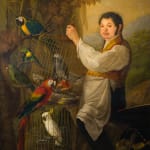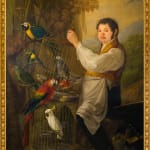Francisco Michans Gargori Spanish, 1777-after 1837
73¾ x 54¼ in. (187.4 x 138 cm) framed
Provenance
Probably commissioned by the Infante Francisco de Paula de Bourbon;
with Sala Parés, Barcelona, 1991;
Spanish Private Collection.
Literature
J. Lopez Terrada: "Nuevos datos sobre el pintor valenciano Francisco Michans Gargori", Archivo de arte valenciano, 2000, vol. 81, p. 39-44.Little seems to be known about Gargori's early life, but he is recorded as having registered at the age of ten in the Sala de Principios dela Academia de San Carlos in Valencia. In 1794 he received his first award and in 1801 is noted as distinguishing himself at the academy with a flower subject. Three years later, on the 4th of November 1804, he won the academy's top monetary award of 20 pesos.
In 1837 Gargori exhibited a flower painting at the Exposicion Nacional which had been commissioned by the Milicia Nacional de Madrid and was subsequently presented to Queen Dona Isabel II. Archives in the Palacio Real in Madrid make reference to commissions and other works he executed between 1829 and 1834. During these years his position at Court was that of 'Pintor Particular' to the Infanta Maria Luisa Carlota, as well as Equerry to the Infante Francisco de Paula de Bourbon. In this capacity he produced two paintings of the royal dogs named 'Fidel' and 'Soliman', commissioned directly by the Infante Francisco. These two pictures are now in the collection of the Royal Palace of La Granja de San Ildefonso which may well be setting of the present painting. According to Cavestany, Michans Gargori was also active as a portrait painter, although not many of his works have been identified. One notable exception is a fine picture of children with 'Perros Daneses' (presumably Great Danes).
This highly important and rare portrait of a court servant was likely a special commission made by the Infante Francisco de Paula de Bourbon. It should be assumed that this was painted around the same time as the two portraits of the royal poodles previously mentioned, possibly in an attempt to capture the family's pets in paint. The fact that the parrots' keeper is depicted with them is perhaps testament to his popularity and loyalty to the royal family and specialised knowledge of the South American tropical birds. His elaborate waistcoat and richly embroidered hat lying on the fruit basket would suggest that he held an important position within the household. His nature can easily be determined by his friendly, engaging smile and his characterful face. Sadly, we can only speculate as to his true nature as no documentary evidence survives describing this fascinating man. The composition is beautifully arranged and balanced. The tower of birds to the left mirrors the keeper to the right. The African grey parrot and Yellow crested cockatoo are shown in their cages while the two macaws look opposite ways. Gargori demonstrates great skill as a painter of people and birds, as well as intricate detail, which he finds on the keeper’s velvet shoes and decoration on the cages.
The parrots depicted are (from top to bottom): Blue and gold macaw, Yellow-collared lovebird and behind it a Parakeet, African grey parrot, Mealy amazon, Scarlet macaw and Yellow-crested cockatoo.



